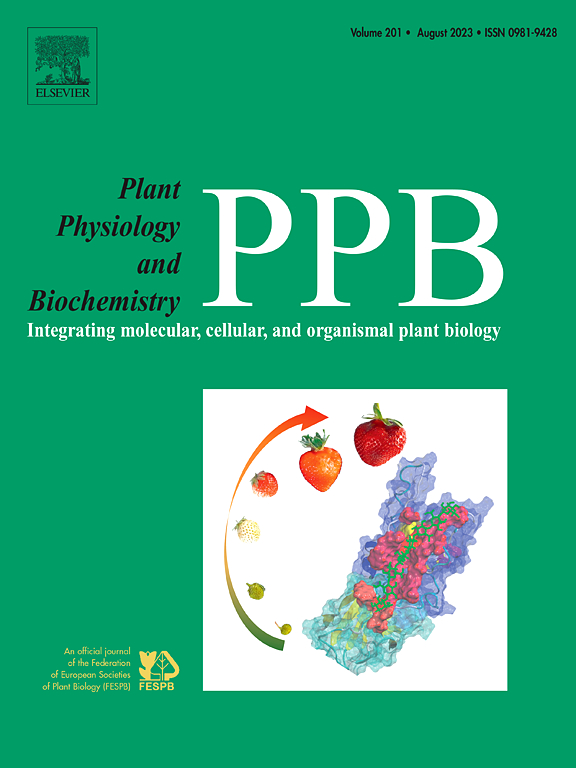PbARP1 enhances salt tolerance of ‘Duli’ pear (Pyrus betulifolia Bunge) through abscisic acid signalling pathway
IF 5.7
2区 生物学
Q1 PLANT SCIENCES
引用次数: 0
Abstract
Pears are a widely cultivated fruit crop; however, the distribution and sustainable production are limited by salt stress. In this study, we identified 35 salt-tolerant genes by means of constructing a yeast expression library. Among the 35 genes, the transcription level of PbARP1 in ‘Duli’ pear (Pyrus betulaefolia Bunge) plants is upregulated under saline stress conditions. Next, we conducted a functional analysis of the PbARP1, the over-expression of PbARP1 in the transgenic pear calli lines exhibited improved tolerance to salt stresses. Conversely, the suppression of PbARP1 resulted in enhanced sensitivity to salt stress. The transcription levels of PbPYL4, PbPYL9, PbPYL8, PbSRK2I, and PbABI5 in PbARP1 silenced pear calli and pear plants presented significant changes, which indicated these genes may be involved in the salt stress response mechanism and regulated by the PbARP1 gene. Besides, we identified an interacting protein of PbARP1: the ABA receptor PbPYL8, highlighting the critical role of PbARP1 and the ABA signalling pathway in regulating pear response to salt stress.

PbARP1通过脱落酸信号通路增强‘ Duli ’梨(Pyrus betulifolia Bunge)耐盐性
梨是一种广泛种植的水果作物;然而,盐胁迫限制了其分布和可持续生产。本研究通过构建酵母表达文库,鉴定了35个耐盐基因。在35个基因中,‘Duli’梨(Pyrus betulaefolia Bunge)植株PbARP1的转录水平在盐胁迫条件下上调。接下来,我们对PbARP1进行了功能分析,PbARP1在转基因梨愈伤组织中过表达表现出对盐胁迫的耐受性提高。相反,PbARP1的抑制导致对盐胁迫的敏感性增强。PbPYL4、PbPYL9、PbPYL8、PbSRK2I和PbABI5在PbARP1基因沉默的梨愈伤组织和梨植株中的转录水平发生了显著变化,表明这些基因可能参与盐胁迫响应机制,并受PbARP1基因的调控。此外,我们发现了PbARP1的一个相互作用蛋白:ABA受体PbPYL8,突出了PbARP1和ABA信号通路在调节梨对盐胁迫的反应中的关键作用。
本文章由计算机程序翻译,如有差异,请以英文原文为准。
求助全文
约1分钟内获得全文
求助全文
来源期刊
CiteScore
11.10
自引率
3.10%
发文量
410
审稿时长
33 days
期刊介绍:
Plant Physiology and Biochemistry publishes original theoretical, experimental and technical contributions in the various fields of plant physiology (biochemistry, physiology, structure, genetics, plant-microbe interactions, etc.) at diverse levels of integration (molecular, subcellular, cellular, organ, whole plant, environmental). Opinions expressed in the journal are the sole responsibility of the authors and publication does not imply the editors'' agreement.
Manuscripts describing molecular-genetic and/or gene expression data that are not integrated with biochemical analysis and/or actual measurements of plant physiological processes are not suitable for PPB. Also "Omics" studies (transcriptomics, proteomics, metabolomics, etc.) reporting descriptive analysis without an element of functional validation assays, will not be considered. Similarly, applied agronomic or phytochemical studies that generate no new, fundamental insights in plant physiological and/or biochemical processes are not suitable for publication in PPB.
Plant Physiology and Biochemistry publishes several types of articles: Reviews, Papers and Short Papers. Articles for Reviews are either invited by the editor or proposed by the authors for the editor''s prior agreement. Reviews should not exceed 40 typewritten pages and Short Papers no more than approximately 8 typewritten pages. The fundamental character of Plant Physiology and Biochemistry remains that of a journal for original results.

 求助内容:
求助内容: 应助结果提醒方式:
应助结果提醒方式:


